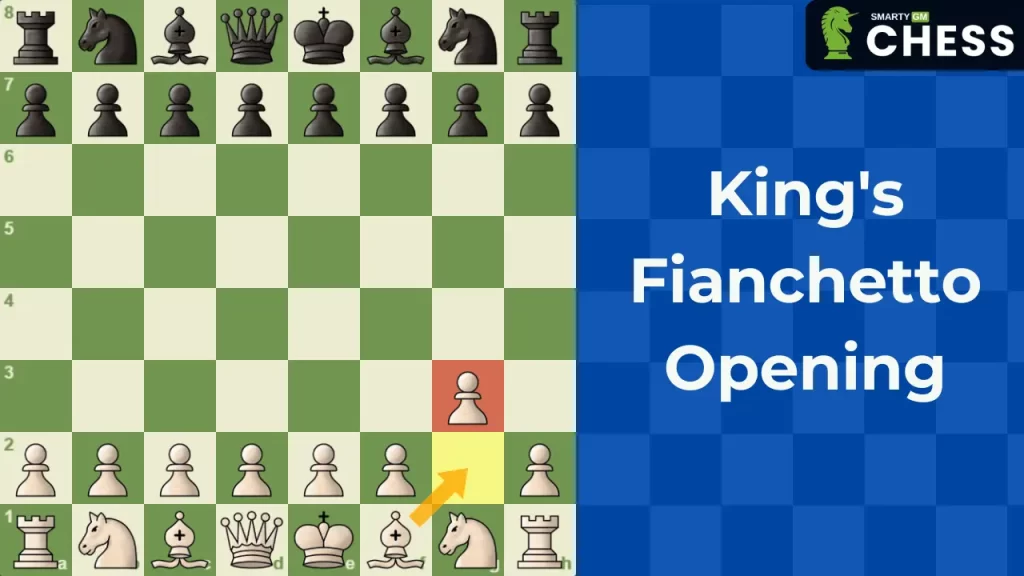King’s Fianchetto is an opening that start with 1. g3 allowing players to fianchetto the king’s bishop early on.
In this article, we delve into the intricacies of The King’s Fianchetto Opening, exploring its history, key concepts, variations, Traps, and enduring impact on modern chess strategy.
Read also: How to Play The Caro-Kann Defense
What is The King’s Fianchetto?
The King’s Fianchetto opening, also known as the Hungarian opening, is characterized by the move 1.g3, which aims to fianchetto the king’s bishop by playing Bg2.
This opening has been played by many grandmasters like Magnus, Hikaru, Kasparov and more…
By fianchettoing the king’s bishop early on, White aims for solid development and prepares to control the center indirectly.
This opening has the element of surprise, and most opponents cannot deal with it.
How you can set up The King’s Fianchetto?
To set up the King’s Fianchetto, you start by playing 1.g4 to make a way for your Bishop to develop to g2, and this Bishop will be a very powerful piece.
After the first move, Black usually responds with Pawn to d5 or e5 to occupy the center.
In this case, you can play c4. If they take, you can take back by playing Qa4 forking the c4-Pawn.
If they take and develop their Bishop, then you can target the b7-Pawn, who is threatening the Rook.
But, the best play I recommend is to play d3 followed by Knight to d2. This move targets the Black central Pawn by pushing e5 or c5.
This move helps to gain control of the center, and you are good to go.
Advantages and weaknesses of The King’s Fianchetto
There are many advantages and disadvantages to The King’s Fianchetto opening, including:
Advantages
- Long-Diagonal Control
- Flexible
- Dynamic Play
- Surprise Value
- Control the center (after some moves)
Weaknesses
- Tempo Loss
Read also: How to Play The Réti Opening
The King’s Fianchetto Traps
Here are some traps in The King’s Fianchetto that enable you to win easily, including:
Trap 1 – Free Rook
Famous games played using The King’s Fianchetto
There are many famous religious players who use The King’s Fianchetto openings like: Hikaru, Magnus, Kasparov, and these are some of their games:
Ian Nepomniachtchi (2770) Vs. Shubin Kirill (2458)
Hikaru Nakamura (2794) Vs. Vladimir Fedoseev (2701)
Best books to learn The Fianchetto
- The Dynamic Benko Gambit” by Sergey Kasparov
- A Cunning Chess Opening Repertoire for White” by Graham Burgess
- Starting Out: The King’s Indian” by Joe Gallagher
- Dynamic Chess Strategy” by Mihai Suba
How to beat The Fianchetto
I’m gonna show you 3 strategy that help to destroy the Fianchetto:
Strategy 1: Trade the Bishop
The best way to beat the Fianchetto is to trade the Bishop by playing Queen to d2 and Bishop to e3:
Strategy 2: blunting the Bishop with c3
blunting the bishop along this diagonal by playing the move c3 and creating this Pawn chain.
All the pawns are defended the bishop is not nearly as effective as it would like to be because if it ever tries to take i will take it back with a pawn.
Strategy 3: blunting the Bishop with e5
This strategy is more aggressive, and it would look something like this:
You would play the move f4, and then at the right moment, you would play e5 and notice again we’re creating this Pawn chain, but it’s further Advanced, and it’s even more annoying because the bishop is ineffective.
Read also: How to Play The Scandinavian Defense
Resources
Frequently asking questions (FAQ)
The King’s Fianchetto opening can be good for players who enjoy aggressive and dynamic play, but it carries risks due to potential weaknesses around the king. Success depends on precise calculation and understanding of its tactical nuances.
You can beat the Kings fianchetto by trading the Bishop and by blunting the Bishop with c3 or e5.



1 Comment
Pingback: The Réti Opening: Basics, Middlegame, and Traps - Smarty Chess